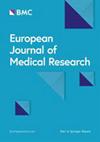POLR3G 的上调与膀胱尿路上皮细胞恶性程度的增加有关
IF 2.8
3区 医学
Q2 MEDICINE, RESEARCH & EXPERIMENTAL
引用次数: 0
摘要
膀胱癌的复发率和进展率很高,仍然是一项重大的健康挑战。本研究旨在评估 POLR3G 在膀胱癌发生和发展过程中的作用,以及 POLR3G 作为新型治疗靶点的潜力。我们通过给 Wistar 大鼠注射 N-丁基-N-(4-羟基丁基)亚硝胺(BBN)构建了膀胱癌模型,成功诱导了正常粘膜向增生过渡,并最终转化为尿路上皮癌。我们观察到,在膀胱癌的发生和发展过程中,POLR3G 的表达逐渐上调。为了研究 POLR3G 的功能作用,我们在膀胱癌细胞系中进行了功能实验。结果表明,敲除 POLR3G 能显著抑制细胞的增殖、迁移和侵袭。我们进一步对敲除 POLR3G 的膀胱癌细胞进行了 RNA 测序,并利用 Metascape 对差异表达基因(DEGs)进行了功能富集分析。富集分析表明,DEGs富集于RNA聚合酶和细胞蛋白凋亡裂解通路,并参与了Wnt和MAPK信号通路。Wnt信号通路相关蛋白如Wnt5a/b、DVL2、LRP-6和磷酸化LRP-6在POLR3G敲除后的下调得到了Western印迹的进一步证实,表明POLR3G可能通过Wnt信号通路影响膀胱癌的行为。我们的研究结果表明,POLR3G 在膀胱癌进展过程中起着关键作用,可作为潜在的治疗靶点。未来的研究应重点关注 POLR3G 调节这些信号通路的详细机制及其作为膀胱癌早期检测和预后生物标志物的潜力。本文章由计算机程序翻译,如有差异,请以英文原文为准。
The upregulation of POLR3G correlates with increased malignancy of bladder urothelium
Bladder cancer remains a significant health challenge due to its high recurrence and progression rates. This study aims to evaluate the role of POLR3G in the development and progression of bladder cancer and the potential of POLR3G to serve as a novel therapeutic target. We constructed a bladder cancer model in Wistar rats by administering N-butyl-N-(4-hydroxybutyl) nitrosamine (BBN), which successfully induced a transition from normal mucosa to hyperplasia and ultimately to urothelial carcinoma. We observed a progressive upregulation of POLR3G expression during the bladder cancer development and progression. To investigate the functional role of POLR3G, we performed functional experiments in bladder cancer cell lines. The results demonstrated that knocking down POLR3G significantly inhibited cell proliferation, migration, and invasion. We further conducted RNA sequencing on POLR3G-knockdown bladder cancer cells, and Metascape was employed to perform the functional enrichment analysis of the differentially expressed genes (DEGs). Enrichment analysis revealed the enrichment of DEGs in the RNA polymerase and apoptotic cleavage of cellular proteins pathways, as well as their involvement in the Wnt and MAPK signaling pathways. The downregulation of Wnt pathway-related proteins such as Wnt5a/b, DVL2, LRP-6, and phosphorylated LRP-6 upon POLR3G knockdown was further confirmed by Western blotting, indicating that POLR3G might influence bladder cancer behavior through the Wnt signaling pathway. Our findings suggest that POLR3G plays a crucial role in bladder cancer progression and could serve as a potential therapeutic target. Future studies should focus on the detailed mechanisms by which POLR3G regulates these signaling pathways and its potential as a biomarker for early detection and prognosis of bladder cancer.
求助全文
通过发布文献求助,成功后即可免费获取论文全文。
去求助
来源期刊

European Journal of Medical Research
医学-医学:研究与实验
CiteScore
3.20
自引率
0.00%
发文量
247
审稿时长
>12 weeks
期刊介绍:
European Journal of Medical Research publishes translational and clinical research of international interest across all medical disciplines, enabling clinicians and other researchers to learn about developments and innovations within these disciplines and across the boundaries between disciplines. The journal publishes high quality research and reviews and aims to ensure that the results of all well-conducted research are published, regardless of their outcome.
 求助内容:
求助内容: 应助结果提醒方式:
应助结果提醒方式:


